Acer Aspire S5 Ultrabook Review: The Steady March of Progress
by Dustin Sklavos on July 9, 2012 7:40 PM ESTSystem Performance
The Intel Core i7-3517U is the second fastest ultrabook processor Intel offers, behind the i7-3667U capable of going all the way to 3.2GHz on a single core. That, coupled with the pair of 128GB SSDs in striped RAID, should allow the Acer Aspire S5 to produce some fairly impressive performance numbers. Intel's HD 4000 graphics are also finally capable of DirectX 11, allowing us to run 3DMark11 and produce comparison results with slightly heavier ultraportable gaming systems.

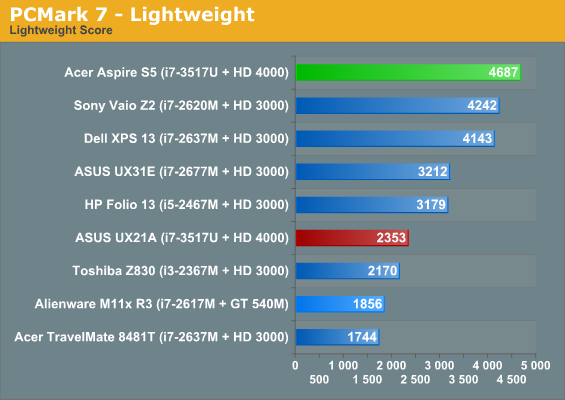
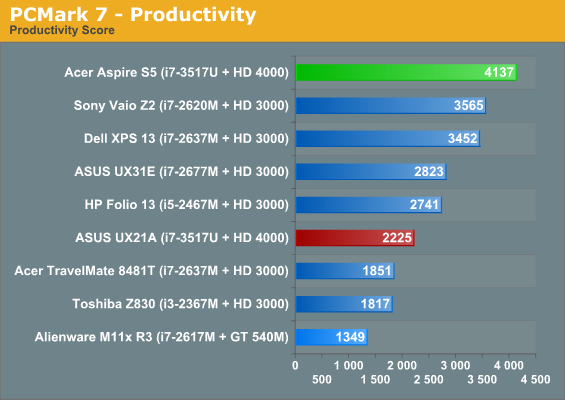
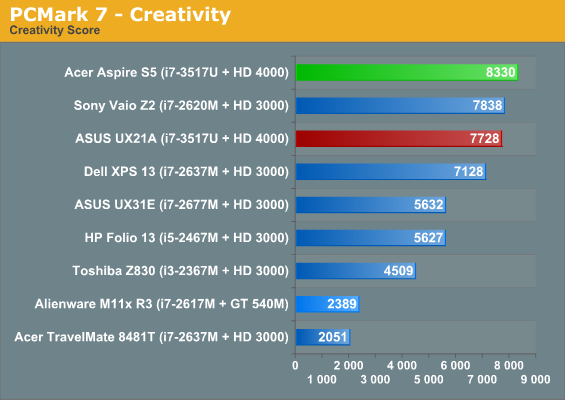
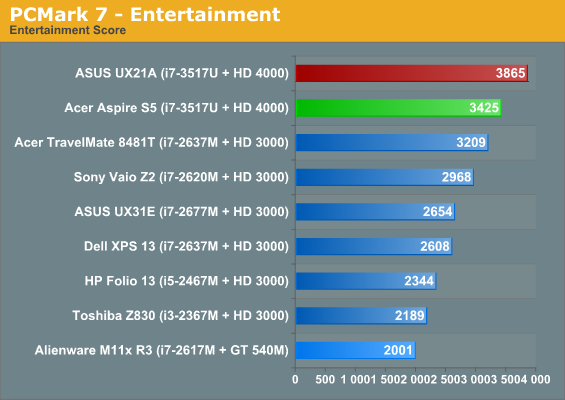
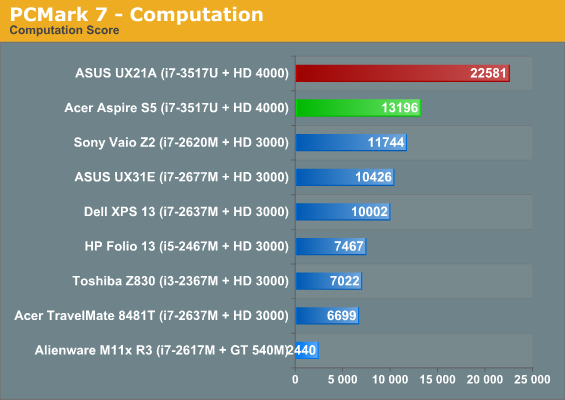
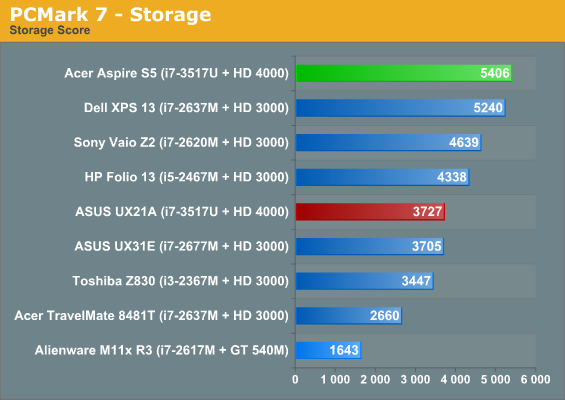
For the most part, the SSD solution in Acer's notebook does indeed seem to be the fastest we've yet tested. That gives it a slight edge against the otherwise comparable ASUS Zenbook Prime UX21A. For reference, even in Microsoft's Performance Advisor, the striped SSD maxes out the score at 7.9.
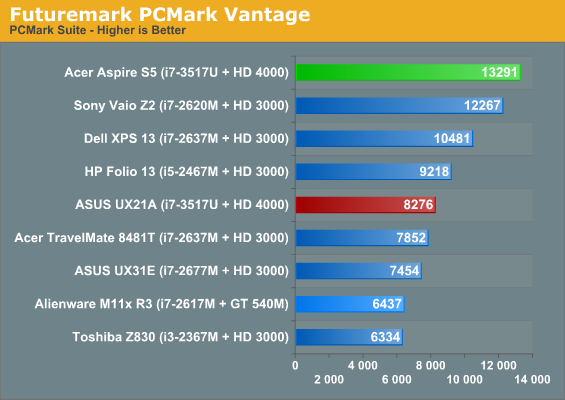
PCMark Vantage tells the same story, favoring faster SSD solutions against virtually anything else.
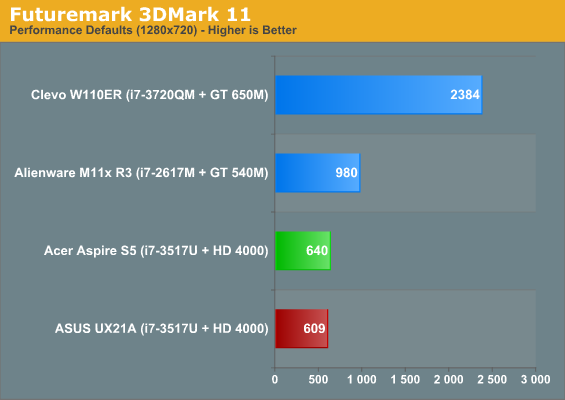
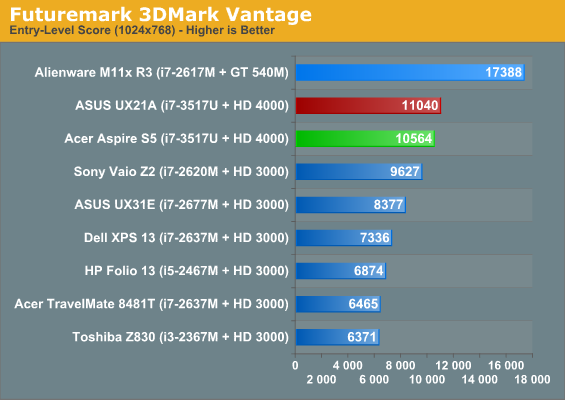

Unfortunately, 3DMark performance remains less than impressive. Pay attention to 3DMarks Vantage and 06 in particular; the faster, standard-voltage CPU in the Sony Vaio Z2 gives the last generation HD 3000 more breathing room and allows it to outperform the otherwise substantially faster HD 4000 graphics core.

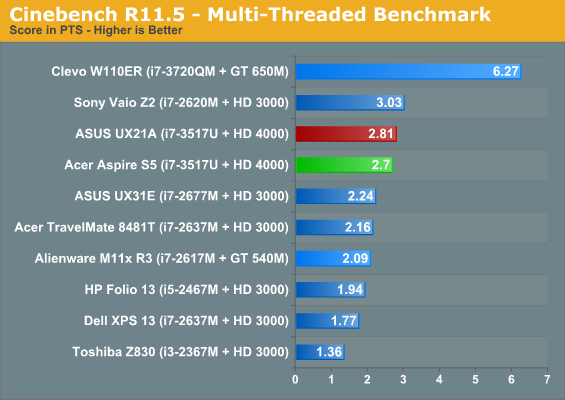
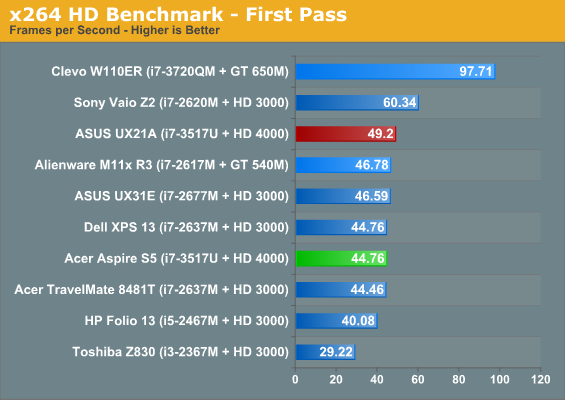
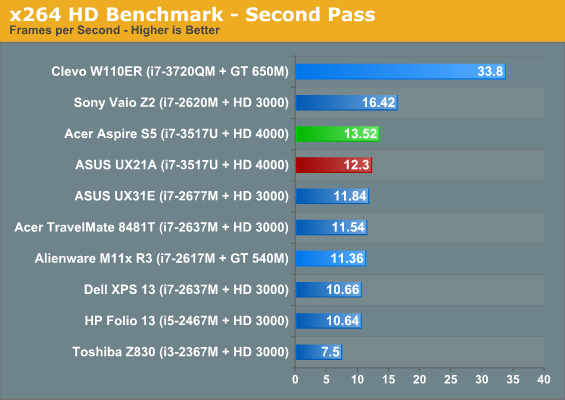
More fundamental CPU performance is about where it ought to be. The S5 and ASUS UX21A tend to trade blows, and I suspect this largely has to do with how each notebook manages its own thermals. For testing, the trap door of the S5 wound up being open the entire time, allowing the S5 to run its processor a little harder.










82 Comments
View All Comments
mrdude - Tuesday, July 10, 2012 - link
No I didn't. I read them.The keyboard is lackluster and provides little feedback. It's shallow. It's shallow because to keep it thin you've got to cut corners, or in this case shave off the tactile nature of the keyboard. The new one is better but still lacks feedback.
The battery life too isn't great. Unless you're under constant load you'll generally have better battery life with a newer full and thicker laptop than an ultrabook, whether Asus Zenbook (prime or not), or Sony or Lenovo or Toshiba. It doesn't matter. The ULV only matters as far as heat output goes and plays a far smaller factor in battery drainage in real life usage.
It's also loud, just like every other ultrabook.
The display, while awesome, sucks because you don't get good OS and application support. A 1080p IPS display sounds amazing on a 13.3" ultrabook until you actually get to play with it and realize it's the worst decision you've made in your entire life. At 13.3", a 768p resolution is actually quite good and had Acer provided an IPS display with great contrast, black levels and color gamut equal to the zenbook prime then I'd prefer the Acer. Scaling DPI in Windows is absolutely horrible.
Finally there's the price. For $1000 you're getting headaches from the poor DPI scaling and something that's thinner than a Portege but also has half the power and costs more.
mrdude - Tuesday, July 10, 2012 - link
I forgot to mention the heat issues. The new Zens suffer from the same heat problems the old ones do. They throttle like mad while under extended load.I'm not saying it isn't an incredible package; it is. It still suffers from poor OS resolution/dpi management, heat, battery life and practicality that a laptop .5lbs heavier can provide with proper and equivalent (minus the CPU) hardware.
As far as I see it, it's a glorified netbook with double the performance and double the problems at 4x the price. Intel needs to either make them much cheaper or start giving people a reason to spend upwards of $1000+ because, forgive me, I'm not seeing the appeal.
JarredWalton - Tuesday, July 10, 2012 - link
Your comment about us "overlooking throttling" may be a bit too strong. I know I check for issues, though most of the time it's more of looking at throttling when performance seems lower than it should be. How would you like us to check for throttling, other than playing games? Do you want us to run a stress test for a solid day? We test for an hour in most cases, running a CPU + GPU load that should reveal any issues.Anyway, there's a difference between throttling down to 1.2GHz on the CPU, and "throttling" down to the base clock speed (e.g. no Turbo Boost active), and it's not clear which case you're talking about. Personally, I'm only concerned when it's the former; if a laptop simply can't hit maximum Turbo Boost under a sustained load, that's working as intended (though we tend to note when performance drops off because of lower average clock speeds).
mrdude - Tuesday, July 10, 2012 - link
Maybe overlook was a bit strong, but it's not mentioned at all. Throttling on ultrabooks is incredibly common and it's generally to the base clocks (like you noted). While this may not seem so bad to you, think about why you're paying for an i5 rather than an i3? Or what happens if you've only got an i3?I saw the comparison between the HD4000 in the ULV and the i7 and the real time GPU clock speeds spell out exactly what I'm referring to.
http://www.anandtech.com/show/5878/mobile-ivy-brid...
There's obvious stuttering going on there and that's on top of an HD4000 that still has gaps to make up as far as response speed when gaming (take a look at the techreport review of Trinity to see what I mean).
If you're not going to be pushing the chips and don't need the ULV for gaming or what-have-you, then why use an expensive ULV in the first place?
There are a lot of issues I see with the ultrabook platform. I like that Intel is pushing manufacturers to get up off their butts and challenge themselves but considering the problems with the heat, the wonky performance, the high prices and that there are already notebooks out there that are within spitting distance of ultrabook size (and some are even lighter...), I'm not seeing the point.
If I'm going to pay a high price for something I'd like to receive a full-fledged product and not something that has obvious drawbacks.
It's like Asus did with the 1080p IPS display on the Zenbook. It sounds great until you actually use it and realize that there are quite a few problems with it when put into practice (the OS can't scale everything).
Impulses - Tuesday, July 10, 2012 - link
It really depends on what you're doing and what programs you're working with... Anything that allows you to easily zoom in/out or shrink/enlarge text isnt gonna be an issue save for the occasional dialog box.. I welcome 1920x1080 @ 13" with open arms, only thing better would be x1200. Win7 scales better than older OS and Win8 will handle it even better.mrdude - Tuesday, July 10, 2012 - link
It's still not handled completely at the OS level meaning your scaling will vary in actual usage depending on the application you're working with. This issue isn't bad on Macs because Apple controls everything with a Stalin-like iron fist (especially the hardware), but on Windows it's going to be exponentially worse.Personally speaking, I'd prefer a 1440x900 or 1366x768 IPS display on a 13.3" form factor at native resolutions without worrying about scaling and zooming than I would the extra real estate that I can't use properly. It's also why I find a 768p display excusable at the sub-14" form factor. 14" 1600x900/1440x900 and 1080p at 15.6" provide enough real estate without the obvious scaling drawbacks.
I find that people latch on to the pixel count and neglect the other important variables in picking out a good display. I'd much rather have a great 1366x768 15.6" matte IPS panel than a 1080p glossy TN panel at 13.3". Pixels aren't everything
IntelUser2000 - Wednesday, July 11, 2012 - link
I feel Turbo Mode isn't explained throughly enough in many sites. This was shown in detail with Itanium "Montecito"'s power management named Foxton.Before it was disabled in the final product version, Foxton used a sophisticated analog power management unit to watch over the chips thermals, and power consumption.
Foxton allowed Turbo, and the gains were heavily application dependent. Essentially, you get the maximum gain in SpecInt and Database type of applications, where the CPU isn't fully loaded and using the power hungry FPU. Opposite is true for SpecFP type of appilcations, where you'd see barely any increase in clocks over Base.
Sandy Bridge/Ivy Bridge's ULV acts very similarly to Foxton. ULV chips basically lower power usage by changing the guaranteed base clocks to Turbo clocks.
That means Turbo Mode in ULV chips is just as much about responsiveness boost(opening applications, editing photos, web browsing, and any "bursty" scenarios) as it is sustained performance boost.
Turbo Mode does work in high end scenarios like when you push CPU and GPU in games(otherwise performance would be half of what it is now), but you won't get full benefit.
Key is again "responsiveness".
IntelUser2000 - Tuesday, July 10, 2012 - link
I can't say much about other things, but I think lot of people will disagree about the display.I guess future manufacturers can offer 1366x768 IPS display with good color reproduction in the future, for people like you.
Shadowmaster625 - Tuesday, July 10, 2012 - link
Having motorized doors is a level a stupidity beyond even apple.But the real question is, what is up with the PCMark 7 Computation score?? UX21A has the same cpu but scores nearly double. Why?
mrdude - Tuesday, July 10, 2012 - link
RAID 0 SSDs in the Acer.